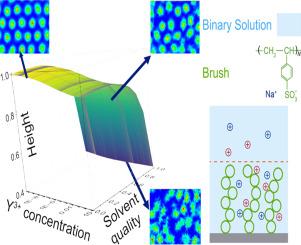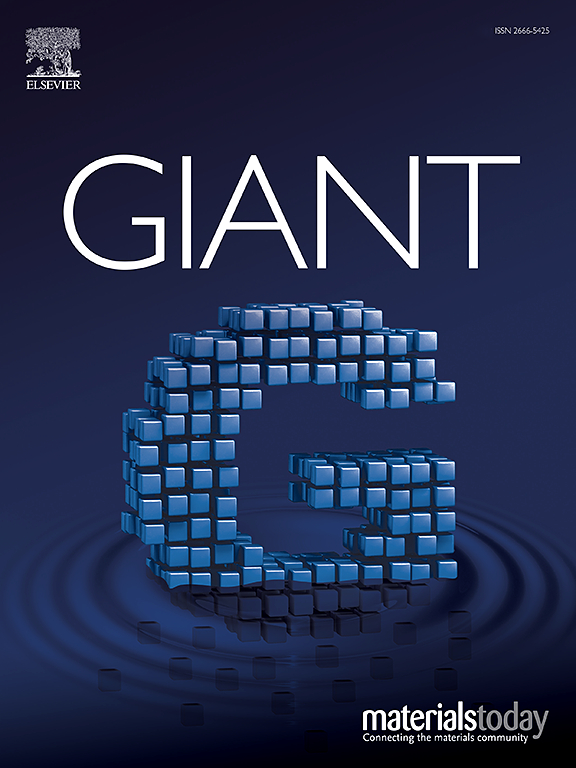溶剂质量和三价离子对聚电解质电刷构象的协同调节
IF 4.9
1区 化学
Q2 CHEMISTRY, MULTIDISCIPLINARY
引用次数: 0
摘要
表面聚电解质电刷材料对溶剂质量和外加离子的响应在界面材料中有着广泛的应用。溶剂质量和离子价之间的相互作用在决定聚电解质电刷的构象中起着关键作用,但其机制尚不清楚。在这项研究中,我们通过理论建模、全原子分子动力学(MD)模拟和原子力显微镜(AFM)实验相结合,系统地研究了这些耦合效应对聚苯乙烯磺酸钠(PSS)刷的影响。通过调整二元溶剂中水与异丙醇(IPA)的比例,我们发现溶剂质量驱动电刷高度逐渐降低,最终在较高的IPA体积分数(本文章由计算机程序翻译,如有差异,请以英文原文为准。

Synergistic regulation of polyelectrolyte brush conformations by solvent quality and trivalent ions
Surface polyelectrolyte brush materials responsive to solvent quality and added ions have widespread applications in interfacial materials. The interplay between solvent quality and ion valency plays a pivotal role in determining the conformation of polyelectrolyte brushes, yet its mechanisms remain underexplored. In this study, we systematically investigate these coupling effects on sodium poly(styrene sulfonate) (PSS) brushes through a combination of theoretical modeling, all-atom molecular dynamics (MD) simulations, and atomic force microscopy (AFM) experiments. By tuning the water-to-isopropyl alcohol (IPA) ratio in binary solvents, we reveal that solvent quality drives a gradual decrease in brush height, culminating in a rapid collapse at higher IPA volume fractions (). Theoretically, we extend our unified framework for ion-valency effects to incorporate Flory–Huggins interaction parameters derived from solvent solubility parameters, yielding predictions consistent with experimental and simulation results. Our findings highlight that the solvent-polymer interactions govern brush height more significantly than dielectric constants in mixed solvents. Solvent-induced brush collapse occurs uniformly, whereas multivalent ions induce localized adsorption, leading to chain aggregation and non-homogeneous collapse. The constructed brush height landscape further demonstrates that solvent quality predominates for short chains, while both solvent quality and ion valency exhibit synergistic and nonlinear effects on longer chains, with pronounced collapse transitions observed under specific conditions. This study provides a comprehensive understanding of the coupled effects of solvent quality and ion valency on polyelectrolyte brushes, offering valuable insights for designing stimuli-responsive surfaces. These findings are particularly relevant for applications in vapor sensing, gas separation, and advanced surface engineering technologies, where precise control over brush height and morphology is crucial.
求助全文
通过发布文献求助,成功后即可免费获取论文全文。
去求助
来源期刊

GIANT
Multiple-
CiteScore
8.50
自引率
8.60%
发文量
46
审稿时长
42 days
期刊介绍:
Giant is an interdisciplinary title focusing on fundamental and applied macromolecular science spanning all chemistry, physics, biology, and materials aspects of the field in the broadest sense. Key areas covered include macromolecular chemistry, supramolecular assembly, multiscale and multifunctional materials, organic-inorganic hybrid materials, biophysics, biomimetics and surface science. Core topics range from developments in synthesis, characterisation and assembly towards creating uniformly sized precision macromolecules with tailored properties, to the design and assembly of nanostructured materials in multiple dimensions, and further to the study of smart or living designer materials with tuneable multiscale properties.
 求助内容:
求助内容: 应助结果提醒方式:
应助结果提醒方式:


